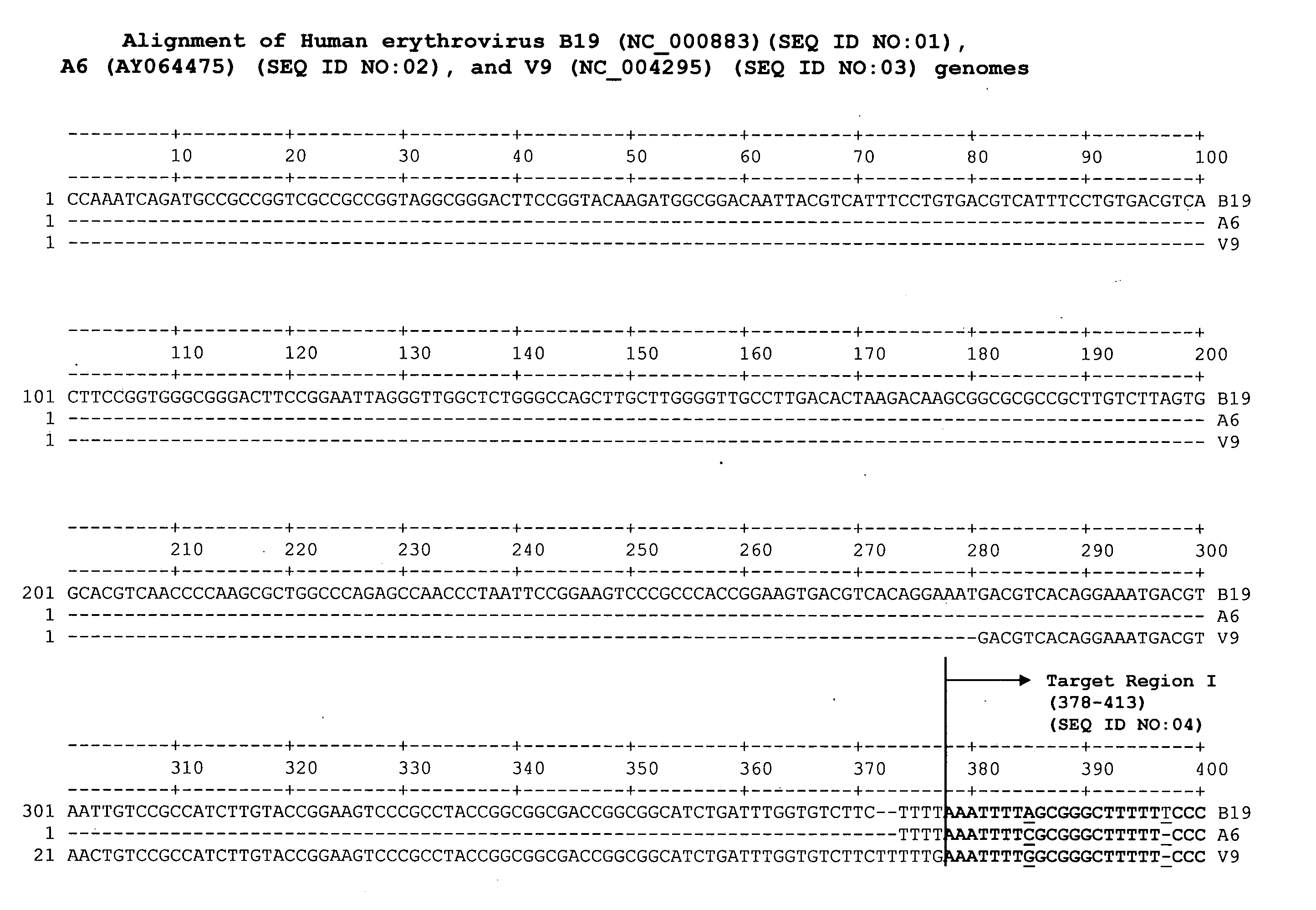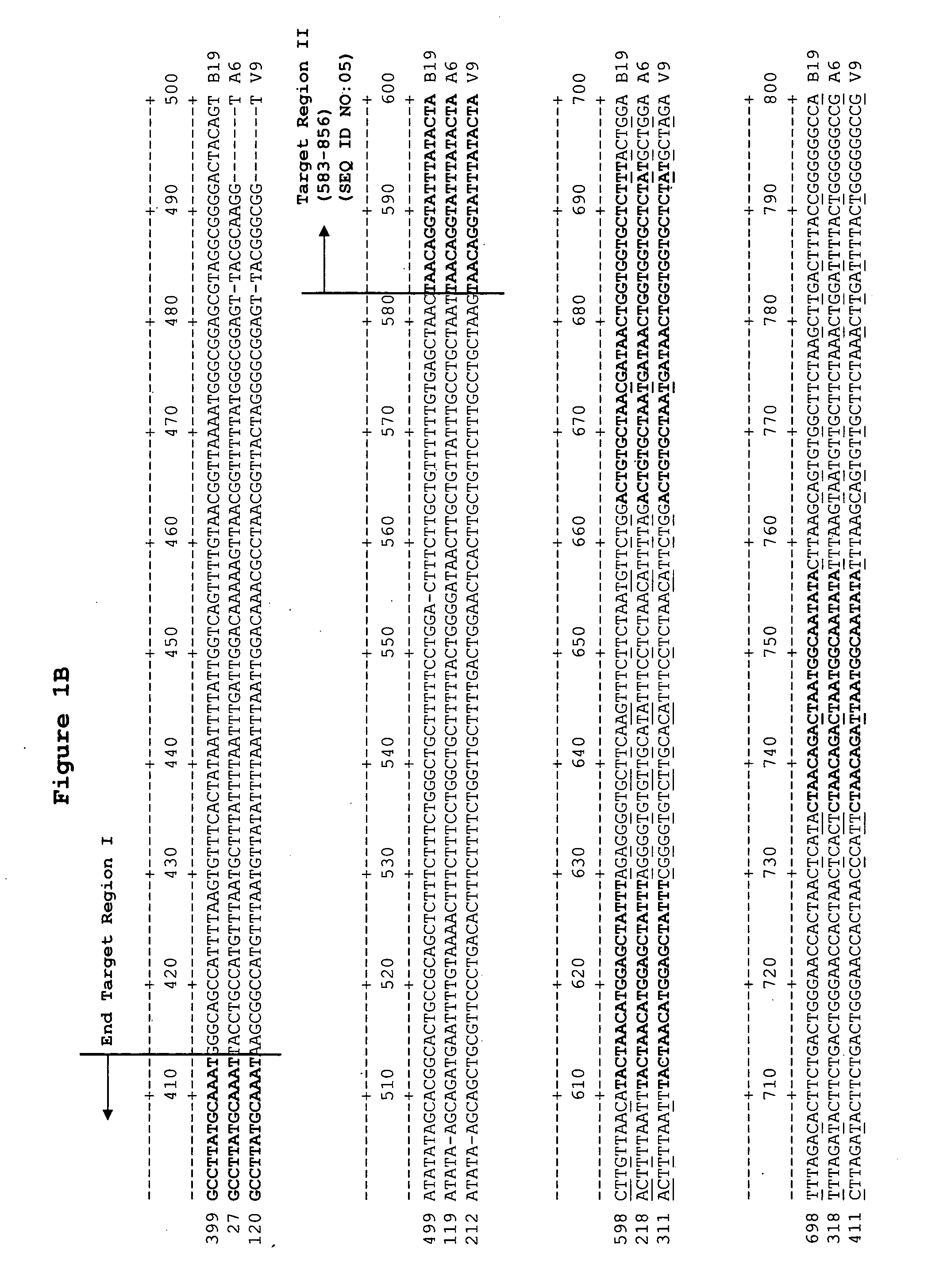Methods and compositions for detecting erythrovirus genotypes
a technology of erythrovirus and genotype, applied in the field of detection of human erythrovirus, can solve the problems of inability to detect recent or current infections using immunological methods, and the inability to detect recent or current infections. , to achieve the effect of reducing the incidence of false negative results and reducing the incidence of false positive results
- Summary
- Abstract
- Description
- Claims
- Application Information
AI Technical Summary
Benefits of technology
Problems solved by technology
Method used
Image
Examples
example 1
Simultaneous Detection and Quantitation of Erythrovirus Genotype 1 (B19), Genotype 2 (A6 / Lali) and Genotype 3 (V9 / D91.1) DNA by Real-time TaqMan PCR
[0243] A defined amount of erythrovirus target nucleic acid, i.e. 1.5×10−2 to 1.5×105 copies per reaction, was amplified and detected by TaqMan PCR reactions. The reaction mixture was in a final volume of 25 μL, which consisted of 12.5 μL 2×universal PCR master mix, primers (0.9 μM) of EF2 (SEQ ID NO:31) and ER2a (SEQ ID NO:33), probe of EP1a (SEQ ID NO:32) (0.2 μM), and 5 μL samples or controls. The reaction conditions included 2 min at 50° C., 10 min at 95° C. and followed by 40 cycles of 15 sec at 95° C., 1 min at 60° C. in the ABI 9700HT Sequence Detection System.
[0244] Following the real-time amplification and detection steps, quantification of the erythrovirus products was made based on standards of known target concentrations. Using the primer pairs of EF2 (SEQ ID NO:31) and ER2a (SEQ ID NO:33) and probe EP1a (SEQ ID NO:32), as ...
example 2
Genotype-specific Detection, Differentiation and Quantitation among Erythrovirus Genotype 1 (B19), Genotype 2 (A6 / Lali) and Genotype 3 (V9 / D91.1) DNA by Real-time TaqMan PCR
[0246] A defined amount of erythrovirus target nucleic acid, i.e. 1.5×10−2 to 1.5×105 copies per reaction, was amplified and detected by TaqMan PCR reactions. The reaction mixture was in a final volume of 25 μL, which consisted of 12.5 μL 2×universal PCR master mix; genotype-specific primers (0.9 μM): SEQ ID:7 and SEQ ID:8 for genotype 1 (B119 genotype) and genotype 2 (A6 genotype) or SEQ ID NO:11 and SEQ ID NO:12 for genotype 3 (V9 genotype); genotype-specific probes (0.2 μM): SEQ ID:9 for genotype 1 (B19 genotype), SEQ ID:10 for genotype 2 (A6 genotype) or SEQ ID NO:13 for genotype 3 (V9 genotype); and 5 μL samples or controls. The reaction conditions included 2 min at 50° C., 10 min at 95° C. and followed by 40 cycles of 15 sec at 95° C., 1 min at 60° C. in the ABI 9700HT Sequence Detection System.
[0247] Fol...
example 3
Genotype-specific Detection, Differentiation and Quantitation among Erythrovirus Genotype 1 (B19), and Genotype 2 (A6 / Lali) DNA by Real-time TaqMan PCR
[0248] A first set of PCR assays (sample group 1) were performed in duplicate with ex-vivo DNA preparations known to contain erythrovirus DNA of genotypes 1 or 2, on the basis of generic (VP1) and specific (K71) qualitative nested-PCRs (Söderlund et al, 1997; Hokynar et al, 2002), and by the REALART™ Parvo B19 LIGHTCYCLER® PCR kit (Artus, Valencia Calif.) (hereinafter “REALART™”) followed by DNA melting point analysis, as described (Hokynar et al, 2004). This sample group included 7 biopsies from skin and 2 from tonsils. The DNA from the skin samples was isolated by phenol-chloroform extraction followed by ethanol-sodium acetate precipitation. The DNA from the tonsil samples was isolated using the QIAamp DNA Mini kit (Qiagen) according to the manufacturer's instructions (Hokynar et al, 2002; Kakkola et al, 2004).
[0249] The second se...
PUM
| Property | Measurement | Unit |
|---|---|---|
| pH | aaaaa | aaaaa |
| temperature | aaaaa | aaaaa |
| temperature | aaaaa | aaaaa |
Abstract
Description
Claims
Application Information
 Login to View More
Login to View More - R&D
- Intellectual Property
- Life Sciences
- Materials
- Tech Scout
- Unparalleled Data Quality
- Higher Quality Content
- 60% Fewer Hallucinations
Browse by: Latest US Patents, China's latest patents, Technical Efficacy Thesaurus, Application Domain, Technology Topic, Popular Technical Reports.
© 2025 PatSnap. All rights reserved.Legal|Privacy policy|Modern Slavery Act Transparency Statement|Sitemap|About US| Contact US: help@patsnap.com



